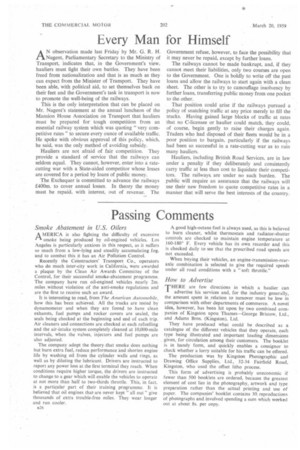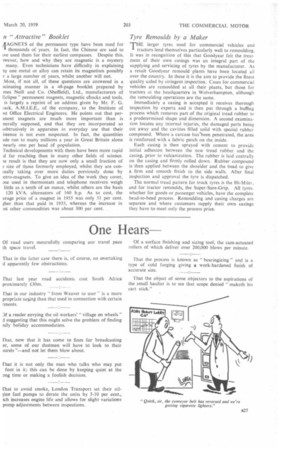Passing Comments
Page 32

Page 33

If you've noticed an error in this article please click here to report it so we can fix it.
Smoke Abatement in U.S. Oilers
AMERICA is also fighting the difficulty of excessive 1-1 smoke being produced by oil-engined vehicles. Los Angeles is particularly anxious in this respect, as it suffers so much from a low-lying and steadily accumulating fog, and to combat this it has an Air Pollution Control.
Recently the Constructors' Transport Co., operators who do much inter-city work in California, were awarded a plaque by the Clean Air Awards Committee of the Control, for their successful smoke-abatement programme. The company have run oil-engined vehicles nearly 2m. miles without violation of the anti-smoke regulations and are the first to receive such an award.
It is interesting to read, from The American Automobile, how this has been achieved. All the trucks are tested by dynamometer and when they are found to have clean exhausts, fuel pumps and rocker covers are sealed, the seals being checked at the beginning and end of each trip. Air cleaners and connections are checked at each refuelling and the air-intake system completely cleaned at 10,000-mile intervals, when the valves, injectors and fuel pumps are also adjusted.
The company adopt the theory .that smoke does nothing but burn extra fuel, reduce performance and shorten engine life by washing oil from the cylinder walls and rings, as well as by diluting the lubricant. Drivers are instructed to report any power loss at the first terminal they reach. When conditions require higher torque, the drivers are instructed to change to a gear which will enable the vehicles to operate at not more than half to two-thirds throttle. This, in fact, is a particular part of their training programme. It is believed that oil engines that are never kept "all out" give thousands of extra trouble-free miles. They wear longer and run cooler.
K26 A good high-octane fuel is always used, as this is believed to burn cleaner, whilst thermostats and radiator-shutter controls are checked to maintain engine temperature at 160-180° F. Every vehicle has its own recorder and this is checked daily to see that the prescribed road speeds are not exceeded.
When buying their vehicles, an engine-transmission-rearaxle combination is selected to give the required speeds under all road conditions with a "soft throttle."
How to Advertise
THERE are few directions in which a haulier can I advertise his services and, for the industry generally, the amount spent in relation to turnover must he low in comparison with other departments of commerce. A novel idea, however, has been hit upon by two combined companies of Kingston upon Thames—George Bristow, Ltd., and Adams Bros. (Kingston), Ltd.
They have produced what could be described as a catalogue of the different vehicles that they operate, each type being illustrated and important loading dimensions given, for circulation among their customers. The booklet is in handy form, and quickly enables a consignor to cheek whether a lorry suitable for his traffic can be offered.
The production was by Kingston Photographic and Drawing Office Supplies, Ltd., 32-34 Fairfield Road, Kingston, who used the offset litho process.
This form of advertising is probably uneconomic if fewer than 500 booklets are ordered, because the greatest element of cost lies in the photography, artwork and type preparation rather than the actual printing and use of paper. The companies' booklet contains 30 reproductions of photographs and involved spending a sum which worked out at about 8s. per copy.
n "Attractive" Booklet
1AGNETS of the permanent type have been used for thousands of years. In fact, the Chinese are said to lye used them for their earliest compasses. Despite this, )wever, how and why they are magnetic is a mystery many. Even technicians have difficulty in explaining hy one metal or alloy can retain its magnetism possibly r a large number of years, whilst another will not.
Most, if not all, of these questions are answered in a scinating manner in a 48-page booklet prepared by mes Neill and Co. (Sheffield), Ltd., manufacturers of Eclipse" permanent magnets, magnetic chucks and tools. is largely a reprint of an address given by Mr. F. G. rack, A.M.I.E.E., of the company, to the Institute of )st Office Electrical Engineers. He points out that peranent magnets are much more important than is nerally supposed, and that they are incorporated so tobtrusively in apparatus in everyday use that their istence is not even suspected. In fact, the quantities acie run to many millions a year in Great Britain alone nearly one per head of population.
Technical developments with them have been more rapid d far reaching than in many other fields of science. le result is that they are now only a small fraction of size of those formerly employed, whilst they are conwally taking over more duties previously done by !ctro-magnets. To give an idea of the work they cover, ose used in thermostats and telephone receivers weigh little as a tenth of an ounce, whilst others are the basis 120 kVA. alternators of 160 h.p. As to cost, the erage price of a magnet in 1955 was only 51 per cent. her than that paid in 1935, whereas the increase in )st other commodities was about 300 per cent.
Tyre Remoulds by a Maker
THE larger tyres used for commercial vehicles and 1 tractors lend themselves particularly well to remoulding. It was in recognition of this that Goodyear felt the treatment of their own casings was an integral part of the supplying and servicing of tyres by the manufacturer. As a result Goodyear remould plants have been located all over the country. In these it is the aim to provide the finest quality aided by stringent inspection. Cases for commercial vehicles are remoulded at all their plants, but those for tractors at the headquarters in Wolverhampton, although the remoulding operations are the same.
Immediately a casing is accepted it receives thorough inspection by experts and is then put through a buffing process which removes part of the original tread rubber to a predetermined shape and dimension. A second examination locates any internal injuries, the damaged parts being cut away and the cavities filled solid with special rubber compound. Where a carcase has'been penetrated, the area is reinforced with a fabric patch on the inside.
Each casing is then sprayed with cement to provide initial adhesion between the new tread rubber and the casing, prior to vulcanization. The rubber is laid centrally on the casing and firmly rolled down. Rubber compound is then applied between the shoulder and the bead to give a firm and smooth finish to the side walls. After final inspection and approval the tyre is dispatched.
The normal tread pattern for truck tyres is the Hi-Miler, and for tractor remoulds, the Super-Sure-Grip. All tyres. whether for goods or passenger vehicles, have the complete bead-to-bead process. Remoulding and casing charges are separate and where customers supply their own casings they have to meet only the process price.












































































































